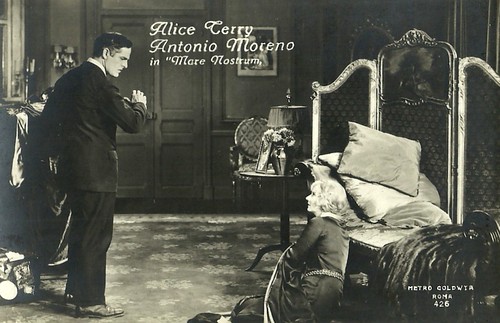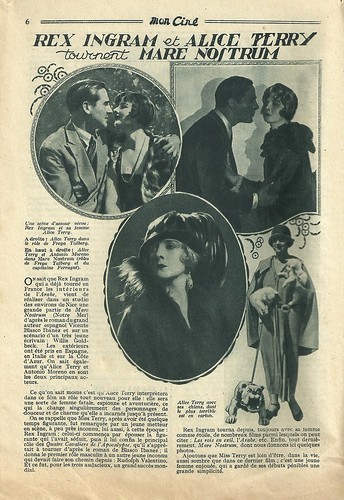Alice Terry and 'Latin Lover' Antonio Moreno were the stars of Rex Ingram's Mata Hari-like drama Mare Nostrum/Our Sea (1926) based on a novel by Vicente Blasco Ibáñez. It is the story of a female Austrian spy who willingly sacrifices her life for her country. Long thought lost, the film has been re-discovered and restored in the 1990s.

Italian postcard, sent by mail in 1927. Photo: Ebany. Antonio Moreno and Alice Terry in Mare Nostrum (Rex Ingram, 1926).

Italian postcard by Ballerini & Fratini, Florence, no. 426. Photo: Metro-Goldwyn-Mayer, Roma. Antonio Moreno and Alice Terry in Mare Nostrum (Rex Ingram, 1926).

Italian postcard by Ballerini & Fratini, Florence, no. 673. Photo: Metro-Goldwyn-Mayer, Roma. American silent film actress Alice Terry amidst the French Alpine Hunters, during a break in the shooting of Mare Nostrum (Rex Ingram, 1926). The 'Alpins' execute her character in the film, freely inspired by the Mata Hari affair. Ingram hired the soldiers to shoot the execution of Terry's Mata Hari-like female spy Freya, on exact the same location at Vincennes where the real Mata Hari had been shot.
In Mare Nostrum, the young Spaniard Ulysses Ferragut (Kada-Abd-el-Kader) is fascinated by his retired uncle’s stories about the sea, particularly his claim to have once seen the sea goddess Amphitrite. Against his father’s wishes, Ulysses becomes a sailor. Kada-Abd-el-Kader was the adopted son of star Alice Terry and director Rex Ingram.
The grown up Ulysses (Antonio Moreno) buys the Mare Nostrum, a fast, modern freighter. He prospers when because of the outbreak of World War One the demand for shipping ends catapults. While visiting the ruins of Pompeii, Ulysses meets the attractive Freya Talberg (Alice Terry), the spitting image of his uncle’s sea goddess, and her female companion, the stern Dr. Fedelmann (Pâquerette).
Ulysses is head over heels in love with Freya and not even the message that the two women are Austrian spies (according to IMDB, German spies) discourages him. Spain is neutral after all. He even helps transporting Count Kaledine (Fernand Mailly) to a secret rendezvous in the Mediterranean, where an U-boat surfaces, takes on fuel from Ulysses' ship, and departs with Kaledine.
Then fate hits hard, as Esteban (Mickey Brantford), Ulysses’ young son, is killed by the same U-boat when returning to Barcelona on a British ship, after trying to find his father in vain. When Ulysses hears this, he vows to avenge his boy. The ice-cold Fedelmann prevents Freya from pacifying and considers her unreliable because of her love for Ulysses. So she lures her to France and betrays her to the French.
Freya suspects the conspiracy and asks Ulysses for help, but he is hurt and refuses, so she is captured, convicted, and shot by a firing squad at dawn. Ulysses then chases and catches the culprit Count Kaledine, helped by the mob, and starts to use his ship in the service of the Allies, arming her with a deck gun, replacing his crew with French military sailors, and transporting munitions to Salonica.
Only long-time family friend and sea cook Caragol (Hughie Mack) refuses to leave him. On the voyage, they are intercepted by the same U-boat again. With the Mare Nostrum torpedoed and doomed, Ulysses mans the abandoned deck gun and sinks the U-boat. As he descends into the ocean depths, Amphitrite rises to embrace and kiss him.

Italian postcard, no. 422. Photo: Metro Goldwyn, Roma. Antonio Moreno in Mare Nostrum (Rex Ingram, 1926).

French film journal Mon Ciné, 5, 204, 14 January, 1926, p. 1.

French film journal Mon Ciné, 5, 204, 14 January 1926, p. 6.

Romanian postcard. Antonio Moreno and Alice Terry in Mare Nostrum (Rex Ingram, 1926).
Sources: Wikipedia and IMDb.

Italian postcard, sent by mail in 1927. Photo: Ebany. Antonio Moreno and Alice Terry in Mare Nostrum (Rex Ingram, 1926).

Italian postcard by Ballerini & Fratini, Florence, no. 426. Photo: Metro-Goldwyn-Mayer, Roma. Antonio Moreno and Alice Terry in Mare Nostrum (Rex Ingram, 1926).

Italian postcard by Ballerini & Fratini, Florence, no. 673. Photo: Metro-Goldwyn-Mayer, Roma. American silent film actress Alice Terry amidst the French Alpine Hunters, during a break in the shooting of Mare Nostrum (Rex Ingram, 1926). The 'Alpins' execute her character in the film, freely inspired by the Mata Hari affair. Ingram hired the soldiers to shoot the execution of Terry's Mata Hari-like female spy Freya, on exact the same location at Vincennes where the real Mata Hari had been shot.
Head over heels in love with an Austrian Spy
In Mare Nostrum, the young Spaniard Ulysses Ferragut (Kada-Abd-el-Kader) is fascinated by his retired uncle’s stories about the sea, particularly his claim to have once seen the sea goddess Amphitrite. Against his father’s wishes, Ulysses becomes a sailor. Kada-Abd-el-Kader was the adopted son of star Alice Terry and director Rex Ingram.
The grown up Ulysses (Antonio Moreno) buys the Mare Nostrum, a fast, modern freighter. He prospers when because of the outbreak of World War One the demand for shipping ends catapults. While visiting the ruins of Pompeii, Ulysses meets the attractive Freya Talberg (Alice Terry), the spitting image of his uncle’s sea goddess, and her female companion, the stern Dr. Fedelmann (Pâquerette).
Ulysses is head over heels in love with Freya and not even the message that the two women are Austrian spies (according to IMDB, German spies) discourages him. Spain is neutral after all. He even helps transporting Count Kaledine (Fernand Mailly) to a secret rendezvous in the Mediterranean, where an U-boat surfaces, takes on fuel from Ulysses' ship, and departs with Kaledine.
Then fate hits hard, as Esteban (Mickey Brantford), Ulysses’ young son, is killed by the same U-boat when returning to Barcelona on a British ship, after trying to find his father in vain. When Ulysses hears this, he vows to avenge his boy. The ice-cold Fedelmann prevents Freya from pacifying and considers her unreliable because of her love for Ulysses. So she lures her to France and betrays her to the French.
Freya suspects the conspiracy and asks Ulysses for help, but he is hurt and refuses, so she is captured, convicted, and shot by a firing squad at dawn. Ulysses then chases and catches the culprit Count Kaledine, helped by the mob, and starts to use his ship in the service of the Allies, arming her with a deck gun, replacing his crew with French military sailors, and transporting munitions to Salonica.
Only long-time family friend and sea cook Caragol (Hughie Mack) refuses to leave him. On the voyage, they are intercepted by the same U-boat again. With the Mare Nostrum torpedoed and doomed, Ulysses mans the abandoned deck gun and sinks the U-boat. As he descends into the ocean depths, Amphitrite rises to embrace and kiss him.

Italian postcard, no. 422. Photo: Metro Goldwyn, Roma. Antonio Moreno in Mare Nostrum (Rex Ingram, 1926).

French film journal Mon Ciné, 5, 204, 14 January, 1926, p. 1.

French film journal Mon Ciné, 5, 204, 14 January 1926, p. 6.

Romanian postcard. Antonio Moreno and Alice Terry in Mare Nostrum (Rex Ingram, 1926).
Sources: Wikipedia and IMDb.
No comments:
Post a Comment